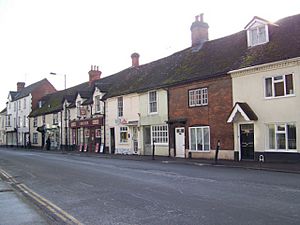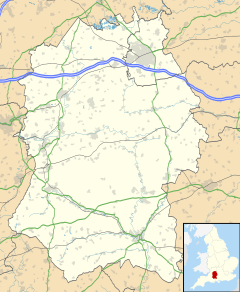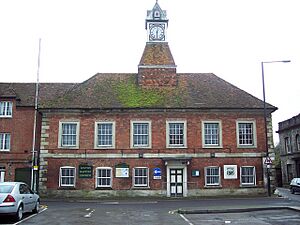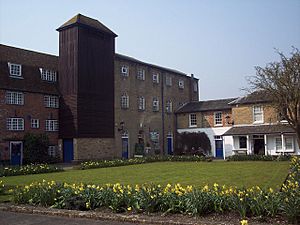Wilton, Wiltshire facts for kids
Quick facts for kids Wilton |
|
|---|---|
 Houses on West Street (A30), Wilton |
|
| Population | 3,579 (2011 census) |
| OS grid reference | SU096312 |
| Civil parish |
|
| Unitary authority |
|
| Ceremonial county | |
| Region | |
| Country | England |
| Sovereign state | United Kingdom |
| Post town | Salisbury |
| Postcode district | SP2 |
| Dialling code | 01722 |
| Police | Wiltshire |
| Fire | Wiltshire |
| Ambulance | Great Western |
| EU Parliament | South West England |
| UK Parliament |
|
Wilton is a town and civil parish in Wiltshire, England. It is located about 3 miles (5 km) west of the city of Salisbury. Wilton has a long and interesting history, going all the way back to the Anglo-Saxons. Until 1889, it was the main town, or county town, of Wiltshire.
Wilton is famous for making carpets, a tradition that started in the 18th century. The town is also home to Wilton House, which is the country home of the Earls of Pembroke. You can find a large and beautiful church here, built in a style called Romanesque Revival. Two rivers, the Wylye and the Nadder, meet in Wilton.
Contents
History of Wilton
The story of Wilton began with the Anglo-Saxons in the 8th century. By the late 800s, it was the capital of Wiltunscire. This was a shire, or county, within the Kingdom of Wessex. Wilton remained the main administrative center for Wiltshire until the 11th century.
Wilton was also very important for the church. Wilton Abbey was founded here in 771, along with other religious places. In 871, Alfred the Great fought a big battle against the Danish armies in Wilton. He lost this battle and had to retreat for several years.
Even after more attacks, Wilton continued to be a successful town. This was recorded in the Domesday Book, a famous survey from the 11th century. However, when Salisbury Cathedral was built nearby, Wilton started to decline. The new city of Salisbury had a new bridge over the River Avon. This made it easier for trade routes to go around Wilton.
In 1539, King Henry VIII took control of Wilton Abbey during a time called the Dissolution of the Monasteries. In 1541, much of the abbey's land was given to William Herbert. He then began building Wilton House. The Old Town Hall was finished in 1738.
In 1889, the Wiltshire County Council was formed. Wilton lost its role as the main county town to Trowbridge. Trowbridge was easier to reach by train from all parts of the county.
Wilton's Economy and Industry
By the 17th century, weaving became a very active business in Wilton. The carpet industry officially started in 1741. Two French weavers were brought to Wilton by Henry Herbert, 9th Earl of Pembroke. They taught the local people new skills for making carpets.
Carpet weaving did very well until 1815. After the Napoleonic Wars ended, there was more competition from other European countries. In 1835, machines were brought in to make Axminster carpets. The Wilton Royal Carpet Factory was started around 1900. This happened with help from Lord Pembroke, to save the carpet factory that was having money problems.
The factory kept making carpets until 1995. It closed for a short time after a new company took over, but then it reopened under a different name. Today, the old factory site is used as a shopping outlet.
Transport in Wilton
When railways arrived, Wilton became more successful. Wilton once had two railway stations. The first, later called Wilton North, opened in 1856. It was part of the Great Western Railway line from Westbury to Salisbury. The second, later called Wilton South, opened in 1859. It was on the West of England line from London Waterloo to Exeter.
Both stations closed down, Wilton North in 1955 and Wilton South in 1966. However, the railway lines are still used today. The closest train station for Wilton is now in Salisbury.
Today, people can travel to and from Wilton using several bus routes. These buses are run by Go South Coast under the Salisbury Reds name. They travel between Salisbury and other places west of Wilton. There is also a special Park & Ride service. This service operates from a car park near Kingsway and The Avenue, taking people into Salisbury city center.
Media and Local News
Local TV news for Wilton is provided by BBC South and ITV Meridian. Television signals come from the Salisbury and Rowridge TV transmitters.
For radio, you can listen to BBC Radio Wiltshire on 103.5 FM. There is also Greatest Hits Radio South (which used to be called Spire FM) on 102 FM. The local newspaper for the town is the Salisbury Journal.
Military Connections
The main office for Land Forces (and similar groups before it) was at Erskine Barracks. This location is northeast of Wilton. It was there from 1949 to 2010. After the headquarters moved to Marlborough Lines near Andover, the land was sold to build houses.
How Wilton is Governed
The borders of the modern civil parish of Wilton were set in 1885. The parish includes the villages of Bulbridge and Ditchampton. In 1894, Wilton also took in the western part of a nearby parish called Fugglestone St Peter. The rest of that parish became a new one called Bemerton.
The people of Wilton elect a town council to manage local matters. Wilton is part of the Wiltshire Council unitary authority. This means Wiltshire Council is in charge of all the important local government tasks. As of 2021, Wilton is in the 'Wilton' electoral division. This area also includes nearby Quidhampton and Netherhampton.
Wilton's Parish Church
The Church of St Mary and St Nicholas is a very important building, listed as Grade I. It was built between 1841 and 1844. It replaced an older church called St Mary's Church, Wilton. The new church was built because Catherine Herbert, Countess of Pembroke and her son Sidney Herbert wanted it. Catherine was the daughter of a Russian ambassador.
The church was designed by architect Thomas Henry Wyatt. It is in the Romanesque Revival style, with many influences from Byzantine buildings. It has a tall 105 ft (32 m) campanile, which is a bell tower.
This church is unusually large for the community it serves. This shows how wealthy the people who paid for it were. Many of the materials used to build it came from other countries in Europe. These include marble columns from Italy and beautiful 12th and 13th century stained glass from France.
Neighbouring Areas of Wilton
 |
Great Wishford | South Newton | Old Sarum |  |
| Barford St Martin | Salisbury | |||
| Burcombe | Netherhampton, Salisbury Racecourse | Salisbury |
Notable People from Wilton
- Dudley Cockle (1907–1986), a cricketer
- Edith Olivier (1872–1948), the first woman mayor of Wilton and a writer
- Sydney Olivier (1870–1932), a cricketer
- Edward Slow (1841–1925), a poet and carriage builder
- A. G. Street, a country author, who farmed at Ditchampton Farm
See also
 In Spanish: Wilton (Wiltshire) para niños
In Spanish: Wilton (Wiltshire) para niños





